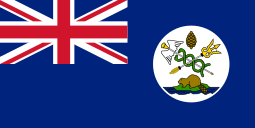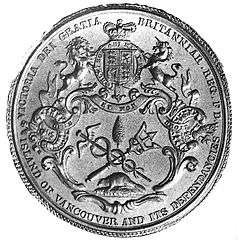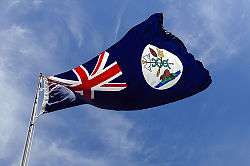Flag of Vancouver Island
The flag of Vancouver Island is a defaced Blue Ensign with the Union Flag in the canton, and the badge of the colony of Vancouver Island on a white disk on the fly. The design of this flag is based on the rules set out by the Admiralty for colonial flags in 1865, and elements from the great seal of the colony of Vancouver Island, established in 1849.[1] However the flag itself likely never existed during this period, but rather was re-created in 1988 as an unofficial local flag for Vancouver Island (now part of British Columbia, Canada).[2]
 | |
| Use | Other |
|---|---|
| Proportion | 1:2 |
| Adopted | Re-created 1988 |
| Design | A Blue Ensign with the badge of the Colony of Vancouver Island on a white disk on the fly. |
Great Seal of the Island of Vancouver and its Dependencies
The distinguishing badge on the fly (right hand side) of the flag of Vancouver Island is based on the great seal of the colony, officially called the Island of Vancouver and its Dependencies. This was designed in 1849/50 in London by Benjamin Wyon (1802-1858), Chief Engraver of Her Majesty's Seals. The seal is on the classic pattern of British colonial seals from the Nineteenth Century, and combines the Royal Arms of Queen Victoria in the top third of the image with the symbols designed for the colony in a highly stylised shield or badge on the bottom two thirds. The principal symbols of the badge are Trident of Neptune and the Caduceus (or wand) of Mercury crossed in saltire. These represent the Pacific island colony’s relationship with the sea and with trade respectively. Above this is set a pinecone, and below is a beaver sitting on a small island surrounded by calm water. These represent the forest and other natural resources of the colony and perhaps also the early connection of the colony to the Hudson’s Bay Company (who also bore beavers on their arms). The seal was only in use from the time of its creation until the union of Vancouver Island with its neighbouring colony on the mainland, British Columbia, in 1866.[1] Aside from their use on the flag of Vancouver Island these symbols have, however, lived on, with a similar version of the British Royal Arms and colonial badge being featured on the masthead of the Victoria Times Colonist newspaper, which originates from the colonial period.

1865 Admiralty Regulations for Colonial Flags
In 1865 the British Admiralty issued regulations for flags flown by British and British colonial ships. In this they directed colonial governments to fly ensigns with the badge of their colony on the fly to distinguish their vessels from ships of the Royal Navy and other British government vessels. This regulation, titled ‘Circular No. 4, Colonial Colours’, directed British colonial governments to fly "the Blue Ensign, with the Seal or Badge of the Colony in the fly thereof…" [3] This regulation was issued late in 1865, and less than a year later the colony was merged with its mainland neighbour, hence it is highly unlikely that this flag ever flew during the colonial period, and indeed no contemporary examples or descriptions of a unique Vancouver island flag are known.
Popular revival
The flag of Vancouver Island existed only theoretically until 1988 when an amateur scholar, Michael Halleran, connected the design of the Great Seal of the colony with the Admiralty regulation of 1865 and determined that the colonial government had been entitled to fly its own flag. In conjunction with a private flag manufacturer in Victoria, Vancouver Island, he combined the elements of the conventional British Blue Ensign and the symbols of Vancouver Island from the great seal, creating a flag which conforms to standard British practices from the period when Vancouver Island was a separate colony.[4]
Since 1988 the flag of Vancouver Island has been manufactured for private sale. Initially it was not much more than an historical oddity, however in recent years, according to a number of local and national news articles the flag has begun to fly more widely, and can be seen flying around Vancouver island, and on the many ships that ply its waters.[5][6]

Colonial, Commonwealth, and Canadian ensigns
British Ensigns have central place in Canadian vexillological traditions. But more often than not it is the red ensign that is most common, with the pre-1965 Canadian national flag being the most famous, along with those still used by the Hudson’s Bay Company, and the provinces of Ontario and Manitoba. Blue Ensigns were not foreign to Canadian practice, Non-Naval Government of Canada ships, Colonial Newfoundland, flew their own blue ensigns, however they were and are far more common in other parts of the former British Empire and modern Commonwealth. To this day the commonwealth realms of New Zealand and Australia, and Australia’s states, fly defaced blue ensigns as their flags. As do several of the remaining British colonies, like the Falkland Islands and the Cayman Islands, and until 1997 Hong Kong.
There appears to be no clear rules as to the choice between red and blue ensigns for colonial and dominion flags, however broadly speaking there seems to a correlation between colonies with a close history with the Royal Navy and the use of the blue ensign. This is consistent with the history of Vancouver Island, which, like Australia and New Zealand, only fell under British control after being surveyed during Captain James Cook's and George Vancouver's explorations of the Pacific from the 1760s to 1790s. The British Government did not formally proclaim Vancouver Island a colony until 1849, and immediately handed over administration of the nascent colony to the Hudson’s Bay Company for a period of ten years. However even in this later period, the connection with the navy remained strong. Long after the voyages of Cook and Vancouver the ships of the Royal Navy were a presence in the North East Pacific, surveying, ferrying and defending colonists, and generally asserting British control. From the early 1840s the navy began to use the harbour at Esquimalt in the extreme south of Vancouver Island, and from the 1850s this naval base became the headquarters of the entire Pacific Squadron of the Royal Navy. Historian J.F. Bosher has gone as far as to argue that Vancouver Island was only nominally Canadian even after the 1866 union of the colonies of Vancouver Island and the mainland colony of British Columbia, and the subsequent union of British Columbia with Canada, in 1871. "Colonised by sea from the British Isles half a century before it became a part of Canada in 1871, Vancouver Island is best understood as part of a worldwide system of island bases that included Aden, Bombay, Cyprus, Gibraltar, Hong Kong, Malta, St Helena, Sydney and Trincomalee (Ceylon). Its character was formed by the Royal Navy as it moved into the Pacific and by other imperial personnel attracted by reports of cheap land in a picturesque landscape, good fishing and hunting, and a British civilisation. Surprising numbers of British officers and civil servants arrived from India and China as well as Britain. Historians from east of the Rockies, busy writing the Empire out of Canadian history, tend to approach the Island’s history through an ideological cloud of nationalism. The result has been an unfortunate distortion of Vancouver Island’s imperial past."[7]
References
- Swann, Conrad. "Chapter I, Arms of dominion and sovereignty and public authority". Canada Symbols of Sovereignty: An investigation of the arms and seals borne from the earliest times to the present in connection with public authority in and over Canada. along with consideration of some connected flags. Toronto: University of Toronto Press.
- "The Flags of Canada by Alistair B. Fraser". Retrieved 2011-11-26.
- Admiralty. The Admiralty List for 1871. London: John Murray.
- "Vancouver Island (British Colony, Canada)". Crwflags.com. Retrieved 2016-04-20.
- "Obscure Vancouver Island flag finds new life - British Columbia - CBC News". Cbc.ca. 2015-04-15. Retrieved 2016-04-20.
- "150 years later, flag flies high for Colony of Vancouver Island". Globalnews.ca. 2015-04-17. Retrieved 2016-04-20.
- Bosher, J.F. (2005). "Vancouver Island in the Empire". The Journal of Imperial and Commonwealth History. London: Routledge. 33 (3). doi:10.1080/03086530500185845.